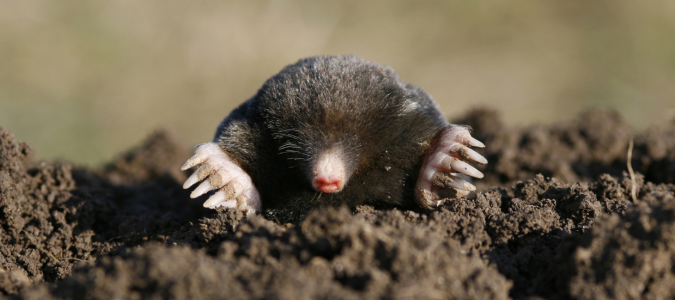Do you know how to identify moles? These pesky creatures live most of their lives underground, making a mole sighting rare for homeowners. However, it’s important for homeowners to understand mole behavior.
You can try several at-home remedies to deter moles from entering your yard. However, once the moles are there, you need to work with a pest control specialist to control them.
An expert will have the right tools and expertise to deal with the problem. They can also help you implement prevention methods to minimize the likelihood of moles coming back in the future.
Ground Moles: Identification Guide
Did you know that ground moles are mammals? These critters feed on grubs, worms and insects and can ingest 60 to 80% of their body weight daily.
Because they eat bugs, ground moles are incredibly beneficial to the ecosystem. However, that doesn’t mean that you want them living on your property.
Ground moles live in tunnels that they dig around ten inches underground. When they live on your property, they can cause significant lawn damage. As a homeowner, it’s important to know how to look out for ground moles so that you can control the problem before more damage is done.
The first thing to understand is that you will likely see the damage done by ground moles before you see a mole itself. Since these creatures spend most of their time underground, spotting one is rare. Instead, you may first notice the damage done by their constant tunnel digging.
Ground moles are the most active in the morning and evening when the soil is moist and easier to move through. Spotting raised tunnels from the mole’s digging is often the first sign of ground mole activity.
What Do Ground Moles Look Like?
If you happen to see a ground mole, it’s important to recognize its characteristics. These critters measure around six to eight inches long and weigh between four and six ounces. They have velvety fur that is either brown, black or gray, and it is so soft that dirt does not stick to it.
They also have tiny eyes that are hard to see because they are covered in fur, which helps to keep dirt out of their eyes. It’s a common misconception that moles are blind. Their ears are also covered by fur and not visible on their faces.
Ground moles are known for their long, pointy and hairless noses that protrude from their faces. They also have large hairless front claws that look like they are too big for their bodies. However, their front claws are used like shovels to dig, which justifies their size. Their back paws are more like flippers with claws, which they use to paddle through the dirt.
What to Do About Ground Moles On Your Property
If ground moles are wreaking havoc on your yard, the best thing to do is call in a professional. Do-it-yourself methods are not an effective long-term solution. An expert will have the right knowledge and experience to deal with the problem so that you can enjoy your lawn again.
Do Moles Come Above Ground?
Ground moles are elusive pests that spend most of their time underground. They prefer the dark and moist environment of their tunnels, which also function as shelter to keep them safe from predators. Since ground moles feed on insects, worms and grubs, they can typically find all the food they need underground.
It’s uncommon for a homeowner to see a ground mole above ground, but not impossible. Occasionally, ground moles will surface to look for food and nesting materials.
Sometimes they can’t access food underground if their tunnels have been flooded or the soil is too compacted for them to dig through. When that happens, usually during a drought or heavy rainfall, ground moles will come up to the ground’s surface to look for food.
Next, they may surface to find nesting materials, such as grass, leaves and other plants. Ground moles like staying warm and cozy in their tunnels and building nests to protect themselves from predators.
Ground moles are most active in the morning and night. If you see one above ground, it will be during those hours.
Recognizing Ground Mole Activity
Since ground moles rarely surface, it’s important for homeowners to understand their behavior and activity so that they can watch out for signs of their presence in their lawns. The most common and obvious sign of a ground mole is seeing raised tunnels scattered throughout your lawn. These tunnels are especially frustrating for homeowners because they can damage your grass, garden and other plants.
If you see a mysterious pile of dirt show up on your lawn, do not wait until there are more to do something about it. Ground moles are voracious diggers and can cause significant damage in a short amount of time. If you spot mole activity on your property, contact a pest control professional to inspect your home for ground moles. They can teach you how to get rid of moles in your yard.
What Do Moles Hate the Most?
While do-it-yourself methods are not effective enough to deal with an existing mole problem, homeowners can do things to deter moles before they take up residence in their yards.
For starters, regular lawn care can help deter moles. Keeping your grass trimmed and properly watered can maintain even moisture levels, which makes the ground less hospitable to moles. Additionally, removing thatch buildup and debris creates fewer hiding spots for insects and worms, which reduces the moles’ food sources.
Another way to eliminate a mole’s food source is to maintain proper pest control in your lawn. Proper watering techniques can go a long way. Be careful not to overwater your lawn, which can increase bug and worm activity and attract moles to your property.
Another extremely effective way to deter moles is to set up a physical barrier that prevents them from getting into your lawn. Since moles are great diggers, the barriers need to be buried underground.
Wire mesh fencing acts as a great barrier, and it should be buried around two feet deep with at least six inches sticking out above ground. It’s especially effective to plant barriers around your gardens, flower beds and other areas of your lawn that are attractive to moles.
Work With a Pest Control Specialist to Remove Moles
While home remedies may help deter moles, they are not enough to rid your lawn of an existing mole problem. The most effective way to get moles out of your yard is to work with a pest control professional.
They will have the expertise, experience and tools to rid your lawn of moles. An expert can also help you put prevention methods in place to keep moles out in the future.
Kick Moles Out of Your Lawn With Expert Help
Homeowners must be vigilant about mole activity because they can cause severe lawn damage, especially to their gardens and flower beds. Understanding their appearance, behavior and activities will help you identify a mole problem in its early stages.
Do not wait until a mole problem becomes advanced to do something about it. Contact your local pest control specialist to inspect your lawn for moles so that you can kick them off your property.
ABC Can Control the Moles on Your Property
Once you realize you have moles in your yard, the best way to deal with them is by contacting a professional mole control service. ABC Home & Commercial Services can control your pest problem, whether you’re dealing with moles, voles or any other type of pest.



